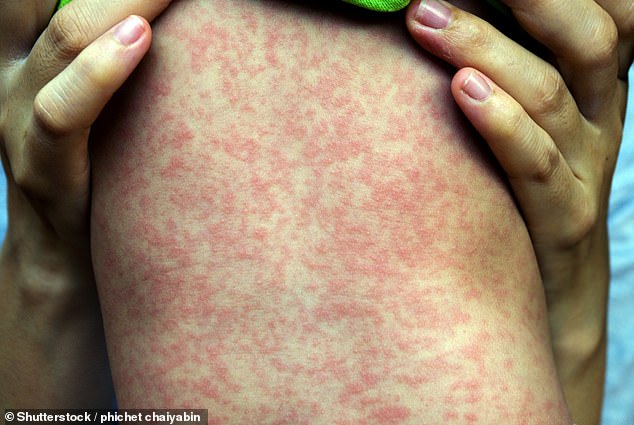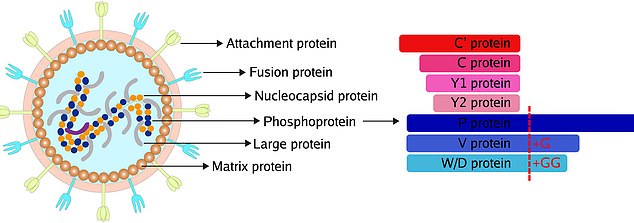Next pandemic deemed the ‘Big One’ could be the most contagious and deadliest disease known to humanity, scientists warn
The next pandemic, dubbed the “Big One,” could continue to “simmer in the background,” waiting to unleash the most contagious and deadliest diseases known to man.
The paramyxovirus family has more than 75 viruses, including mumps, measles and respiratory infections, and was added to the National Institute of Allergy and Infectious Diseases’ list of pandemic pathogens in October.
One of the viruses, the Nipah virus, can infect cells with receptors that regulate what comes in or out of the cells that line the central nervous system and vital organs.
This variant has a mortality rate of up to 75 percent compared to that of Covid, which is well below one percent.
Scientists note that, unlike the flu and Covid-19, paramyxoviruses do not appear to mutate as they spread, but have become “very good at transmitting between people.”
One of the viruses, the Nipah virus, can infect cells with receptors that regulate what comes in or out of the cells that line the central nervous system and vital organs. This variant has a mortality rate of up to 75 percent compared to that of Covid, which is well below one percent
“Imagine if a paramyxovirus emerges that is as contagious as measles and as deadly as Nipah,” Michael Norris, Ph.D., assistant professor at the University of Toronto, said in a statement.
It’s not hard to imagine that scenario: the 2011 film Contagion was based exactly on this kind of imagined paramyxovirus.
Starring Matt Damon, Gwyneth Paltrow and Kate Winslet, a woman returns home from a business trip in Hong Kong and brings back a deadly microbe that caused a global pandemic: the disease was the Nipah virus.
“Influenza has been declared a death,” said Benhur Lee, a virologist at the Icahn School of Medicine at Mount Sinai. The Atlantic Ocean.
Lee went on to explain that this is not the case for paramyxoviruses, as most people infected with any of the more than 75 viruses do not survive, making it virtually impossible to develop treatments and vaccines.

Scientists note that, unlike the flu and Covid-19, paramyxoviruses are “rapid shapeshifters” and do not appear to mutate as they spread, but have become “very good at transmitting between people.”

The paramyxovirus family has more than 75 viruses, including mumps, measles and respiratory infections. Measles causes horrific skin rashes (photo)
The first discovered in the family, called Runderpest, was identified in 1902.
Rinderpest, or rinderpest, is a contagious viral disease that affects cloven-hoofed animals.
It was the second disease ever to be completely eradicated in 2011, after smallpox in humans in 1980.
Even though scientists have known about paramyxoviruses for more than a century, they have yet to understand how the viruses move into new strains and mutations adopted to infect humans.
For example, mumps was long believed to only infect humans and certain primates, but cases have been found among bats.
There is also a mystery about how paramyxoviruses can cause minor infections in one host but kill another.

Although scientists have known about paramyxoviruses for more than a century (pictured), they have yet to understand how the viruses evolve into new species and how the mutations are adopted to infect humans.
Paul Duprex, a virologist at the University of Pittsburgh, told The Atlantic that rubula viruses, one of the paramyxovirus subfamily to which mumps belongs, are of concern.
Humans, monkeys, pigs and dogs are natural hosts and are easily infected at close range.
And then there’s measles, first documented in the 9th century by a Persian physician.
It was not until 1757 that a Scottish physician discovered an infectious agent in the blood of patients that caused the virus.
Emmie de Wit, head of the molecular pathogenesis division at Rocky Mountain Laboratories, told The Atlantic that measles could eventually be eradicated, ending the need for vaccinations.
However, when this happened with smallpox, mpox seemed to take its place.
Strengthening Australia’s Pandemic Preparedness, a report published in 2022, addresses paramyxoviruses: ‘As the world increasingly understands these links between human, animal, plant and environmental health, viruses are moving from animals to humans at ‘alarming rates’.
‘In addition to the known viruses, an average of two new viruses appear in humans every year, and the share that gives rise to larger outbreaks is increasing.
“Many of these viruses have pandemic potential – the potential to spread across multiple continents.”
